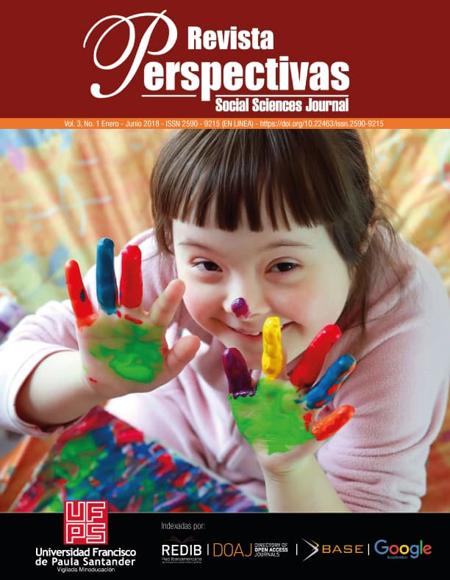Análisis de las técnicas de enseñanza-aprendizaje para la elaboración de un protocolo terapéutico en infantes escolarizados con Síndrome de Down
Análisis de las técnicas de enseñanza-aprendizaje para la elaboración de un protocolo terapéutico en infantes escolarizados con Síndrome de Down
Main Article Content
Communication is one of the skills on which the construction of societies is based, because through it, thought and ideas are individually organized and the collective exchange of ideas, the sharing of opinions (diverse or found), is carried out. which allows to activate the complex network of social relations. Among all human practices of communication, language undoubtedly constitutes the most perfect and finished system, since at the same time it allows the elaboration of complex types of thought, it also favors its socialization. Although linguistic development accompanies every person throughout their life, it is a faculty that naturally activates itself early in the critical period of early childhood. In the case of people with Down Syndrome there are usually difficulties in linguistic development, both in its gold and written aspects, which becomes a barrier in the process of social adaptation and academic training. One of these difficulties has to do with the development of skills in the graphic gesture. In this direction, the intention of the present study, of documentary nature, has been to establish a synthesis on a set of indicators related to teaching-learning techniques, execution skills and the use of objects and elements for the development of the graphic gesture in a protocol of therapeutic intervention in infants enrolled with Down syndrome. The results represent a set of indicators and reference strategies for the professionals who are in charge of the therapeutic intervention. This protocol details the guidelines and actions to be followed in relation to each of the aspects related to the development of the graphic gesture in children with Down Syndrome.
Downloads
Article Details
Arias, F. (2012). El Proyecto de investigación. Introducción a la metodología científica. Caracas: Episteme.
Ávila Álvarez, A.; Martínez Piedrola, R.; Matilla Mora, R.; Máximo Bocanegra, M.; Méndez Méndez, B.; Talavera Valverde, M. A. et al. (2012). Marco de trabajo para la práctica de la terapia ocupacional: Dominio y proceso. 2ºed [traducción]. Disponible en: http://www.terapia-ocupacional.com/aota2010esp.pdf traducido de: American OccupationalTherapyAsociation (2008). OccupationalTherapyPractice Framework: Domain and Process.
Crosso, C. (2010). El derecho a la educación de personas con discapacidad: impulsando el concepto de educación inclusiva.Revista latinoamericana de educación inclusiva, 4(2), 79-95. Disponible en: http://www.repositoriocdpd.net:8080/bitstream/handle/123456789/413/Art_CrossoC_DerechoEducacionPersonas_2010.pdf?sequence=1
De la Iglesia, J. C. F. y Cancela, M. J. B. (2003). La educación de personas con Síndrome de Down: estrategias de aprendizaje. Santiago de Compostela: Universidade de Santiago de Compostela.
Silos Suárez, A. (2015). Viviendo el deseo de los padres.Reflexión sobre la experiencia de los padres de hijos con discapacidad intelectual.Revista Virtual Canal Down21, 164. Disponible en: https://www.down21.org/revista-virtual/revista-virtual-2015/1391-revista-virtual-enero-2015-numero-164/articulo-profesional-el-deseo-de-los-padres.html
Gobierno Vasco. Departamento de Educación, Universidades e Investigación. (2009). Las competencias básicas en el Sistema Educativo de la Comunidad Autónoma de País Vasco. [Documento en Línea]. Disponible en http://www.euskadi.eus/contenidos/informacion/dig_publicaciones_innovacion/es_curricul/adjuntos/14_curriculum_competencias_300/300002c_Pub_BN_Competencias_Basicas_c.pdf
Marichal, C. (2017). Inclusión educativa de niños con Síndrome de Down a través de la psicomotricidad. Trabajo de fin de grado de maestro en educación infantil.Tenerife: Universidad de la Laguna. Disponible en: https://riull.ull.es/xmlui/bitstream/handle/915/5147/INCLUSION%20EDUCATIVA%20DE%20NINOS%20CON%20SINDROME%20DE%20DOWN%20A%20TRAVES%20DE%20LA%20PSICOMOTRICIDAD.pdf?sequence=1
Murillo, M. (2014)Atencion temprana. Niños con síndrome de Down y otros problemas de desarrollo. Madrid: Federación Española del Síndrome de Down. Disponible en http://www.sindromedown.net/wp-ontent/uploads/2014/09/30L_atenciontemprana.PDF
Rodríguez, A. (2013), La integración e inclusión escolar de los niños con Síndrome de Down. Trabajo final de grado en Educación Primaria. Valladolid: Universidad de Valladolid. Disponible en http://uvadoc.uva.es/bitstream/10324/3937/6/TFG-G310.pdf
Romero Pérez, C. y Pereira Domínguez, C. (2011). El enfoque positivo de la educación: aportaciones al desarrollo humano. Teoría de la Educación, 23(2), 69-89.
Ruiz Rodríguez, E. (2012). Programación educativa para escolares con síndrome de Down. Madrid: Publicaciones Down 21. Disponible en: http://www.down21materialdidactico.org/libroEmilioRuiz/libroemilioruiz.pdf
Ruiz Rodríguez. E. (2004). La integración escolar de los niños con síndrome de Down en España: algunas preguntas y respuestas. Revista síndrome de Down, 21(4), 122-133. Disponible en: http://revistadown.downcantabria.com/wpcontent/uploads/2004/12/revista83_122-133.pdf
Rodríguez, E. (2012). Actitudes, estereotipos y prejuicios: su influencia en el síndrome de Down. Revista Síndrome de Down, 29, 110-121.
Vallejos. N. (2010). Patrones de confrontación. El cuerpo de escritura. Blog en línea. Disponible en: http://peritoscaligrafoscba.blogspot.com/2011/07/patrones-de-confrontacion-el-cuerpo-de.html




 Perfil Google Scholar
Perfil Google Scholar



